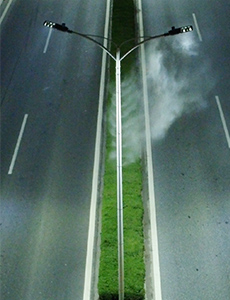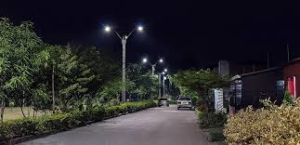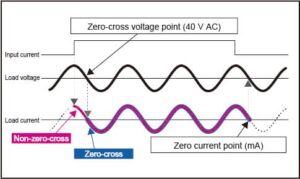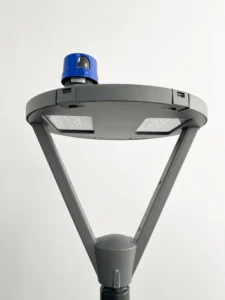Revolução da iluminação pública no Reino Unido em 2030: a tecnologia de fotocélulas inteligentes é o futuro da iluminação urbana
Introduzir
As the UK gears up to decommission over 1.5 million streetlights by 2030, the goal is bigger than energy savings. It’s about transforming how cities operate. Solar panels, LED systems, and smart photocell lighting sensors are taking center stage—powering up a greener, more efficient future. For lighting tech experts like Longjoin Electronics, this is more than a trend—it’s a mission. Our mission rests on decades of commitment. We deliver smart, tough, flexible lighting solutions.

Why Are UK Cities Pushing for Smarter Street Lighting?
Cities across the UK are dealing with aging infrastructure. They’re also facing ever‑higher energy bills. Public pressure is growing to go green and cut costs. Local councils are rethinking old lighting systems. The answer? Modern smart systems. They adapt, optimize, and automate operations.
Traditional street lights are old and waste energy. They also cost too much to keep running.
This shift isn’t just about politics. It’s also practical. Local councils must cut energy costs. They must meet Net Zero by 2050 and reduce manual tasks.
With dusk-to-dawn photocell sensors, remote control lighting, and photocell switches, cities can now automate when and how streetlights operate. This drastically reduces waste, increases lamp life, and helps detect faults faster.
Challenges of Traditional Street Lighting vs. Smart Photocell Systems
Problem with Old Systems | Smart Photocell Lighting Advantage |
Fixed on/off times waste energy | Auto-adjusts using photocell control based on light |
Costly maintenance checks | Remote diagnostics reduce on-site visits |
Shorter LED lifespan due to surges | Surge-protected photo cell sensors extend lamp life |
Zero adaptability to weather/season | Smart sensors adjust with climate and usage |
How Does a Photocell Sensor Improve Outdoor Lighting?
Imagine a system that thinks for itself. A sensor de fotocélula makes lighting more efficient. It cuts energy waste. This small yet powerful component reacts instantly to real-world light. It needs no manual switches or timers.
A photocell sensor notices when natural light changes. It then switches lights on or off. The auto‑detect feature turns lights on only when needed. It saves power, cuts wear, and removes human error.
When integrated into modern fixtures like LED street lights with photocells, this sensor tech adds a layer of intelligence to lighting systems.
These photoelectric sensors:
- React to real-time ambient lighting
- Adapt to seasonal light changes
- Offer fail-safe modes in the event of outages
- Reduce peak energy loads in residential areas
By using photocell lighting sensors, cities cut energy usage without sacrificing safety or visibility.

What Makes Longjoin’s Photocell Products Ideal for the UK’s Climate?
The weather in the UK changes fast. You can see sun, rain, and wind all in one day. And streetlight systems need to be ready. Many generic photocells fail when exposed to extended dampness or fluctuating temperatures. Longjoin builds against those odds.
Because the UK weather is unpredictable, and poor-quality components can’t handle the variation.
Longjoin's JL-243 photocell series is IP65/IP67-rated, meaning they are resistant to both dust and heavy rain. This is vital for rural and coastal regions with high humidity or storms.
Key Features Built for the UK:
- UV-stabilized enclosures to prevent weather degradation
- Zero-cross switchingin JL-207C5-L to prevent inrush current damage
- Smart remote control switch compatibility via ZigBeee LoRa
- Temperature resistance for performance in cold winters and hot summers
Whether it’s fog in Leeds or rain in Bristol, these outdoor photocell light sensors stay reliable.
How Are These Photocells Installed in UK-Approved Fixtures?
Installation delays and retrofitting are major barriers to smart city adoption. Longjoin solves this by offering universal socket compatibility, ensuring lighting manufacturers can upgrade without re-engineering existing fixtures.
Longjoin offers full socket compatibility for British manufacturers, from Receptáculos NEMA de 7 pinos to Zhaga book 18 connectors.
- Twist-lock installations
- Tool-free wiring
- Controller + cap combinations
This ensures manufacturers don’t need to overhaul fixture designs just to upgrade lighting controls.
Longjoin Sockets for Smart Photocells
Tipo de soquete | Compatible Use |
NEMA 7-pin | Smart city lighting with remote control systems |
Soquete Zhaga | Sleek, compact fixtures with wireless modules |
Shorting cap | Non-smart LED fixtures |
4-pin connector | Hybrid smart systems |

What Communication Technologies Are Embedded in These Devices?
Without proper communication systems, smart lighting is just lighting. The value lies in data—and Longjoin equips their photocells with multiple communication protocols to unlock that power.
Lighting needs to talk—and Longjoin makes sure it does.
The future of street light controllers is wireless. Longjoin photocells support:
- ZigBee (for mesh networks in urban clusters)
- LoRa (for long-range rural communication)
- NB-IoT (for high-density smart city platforms)
This means each photocell isn’t just a switch—it’s a data node.
- Track power consumption
- Monitor lamp health
- Receive alerts when faults occur
This proactive management reduces downtime and maintenance costs.
How Do Photocells Align with the UK’s Green Policy Goals?
Government mandates are getting stricter—and infrastructure must evolve to comply. Lighting systems can no longer be passive. They must contribute to decarbonization and energy transparency.
The UK government’s Net Zero 2050 and 2035 fossil-free grid mandates require infrastructure that actively reduces carbon emissions—and adapts as policies evolve.
Smart lighting powered by photocell street light technology plays a key role.
Longjoin’s commitment to this mission is clear:
Their UL, CE, and ISO-certified products ensure immediate compatibility with UK lighting standards.
Why Are OEMs and Municipalities Choosing Longjoin?
Local governments and lighting manufacturers face unique challenges—from branding to network compatibility. Longjoin meets these needs with flexibility, technical know-how, and decades of global experience.
Because they need a reliable partner—not just a parts provider.
Longjoin offers full-service OEM/ODM customization, allowing clients to personalize:
- Timer delays
- Logos and branding
- Sensor calibration ranges
- Fail-safe response logic
Add to that:
- A global logistics network
- Technical consultation for integration
- After-sales support
And it’s clear why Longjoin is a leading manufacturer of photocell sensors trusted in over 30 countries.
Conclusão
The UK’s lighting evolution isn’t about turning off—it’s about switching on smart. As cities invest in photocell LED street light solutions, the goal is clear: better efficiency, greener infrastructure, and smarter control.
With Longjoin’s weatherproof, intelligent, and policy-aligned systems, the transformation becomes not just possible, but easy to implement.
Whether you’re a city planner, OEM partner, or sustainability consultant, Longjoin’s photocell controllers are your bridge to the future.
Links externos:
●https://www.un.org/en/climatechange/net-zero-coalition
●https://www.polycase.com/techtalk/ip-rated-enclosures/ip65-vs-ip67.html
●https://en.wikipedia.org/wiki/Zero-crossing_control
●https://www.digi.com/solutions/by-technology/zigbee-wireless-standard
●https://en.wikipedia.org/wiki/LoRa
●https://www.torkglobal.com/us/en/index.html
●https://www.philips.com/global





